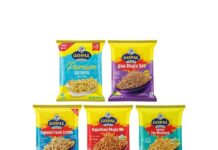
The market for sensitive beverages is flourishing. Throughout the world, manufacturers of dairy products have recognized the potential of wholesome beverages and expanded their product portfolio over the past few years. Most of the new products are filled into PET bottles. With its new linear InnoPET BloFill ABF aseptic block, KHS satisfies the dairy industry’s requirements for flexible filling technology for sensitive products. Fast format changeovers and modular design are the ideal solutions to the rapid changes in demand producers are now faced with.
Sensitive beverages are becoming increasingly popular all over the world. The demand for functional foods with less sugar, in particular, is growing. “Keeping to a healthy diet plays a central role in the lives of more and more consumers,” explained Thomas Redeker, sales director for Dairy Europe at the KHS Group. “The demand for products that are sustainably packaged and attractively presented has also greatly increased in the last few years.”
Dairy industry innovations filled into PET containers
PET bottles are the ideal vehicles for this new trend. An increasing number of makers of dairy products are thus relying on containers made of polyethylene terephthalate. “Not only producers but also consumers are convinced by their many different advantages,” Redeker said.
In particular, this includes a good capacity for the individual design this type of container has. “PET bottles lend themselves to the exclusive design. The cap and label can also be perfectly tailored to the brand. This had a positive effect on the brand positioning at the point of sale,” Redeker added.
The plastic containers also score when it comes to their environmental balance as they are fully recyclable. PET bottles not only offer reliable product protection; they also have good pouring properties, KHS said.
KHS satisfies customer & consumer demands with new block
KHS first recognized the potential of PET containers for aseptic filling 25 years ago. Its latest development is the linear InnoPET BloFill ABF aseptic block. This combines the rotary InnoPET Blomax Series V stretch blow molder with the linear Innosept Asbofill ABF 712 aseptic filler.

According to KHS, the block yields many benefits. It not only takes up less space than the individual machines; for instance, the air conveyor is also no longer required. This cuts down on energy consumption. Another advantage is that personnel costs are reduced as only one operator is needed in place of the former two. “By blocking the machinery and including a continuous clock module, we also minimize the risk of soiling. This has a positive impact on hygiene and line availability,” Redeker added.
Fast format changeovers within the space of up to ten minutes, according to KHS, also help boost system availability. They are performed under aseptic conditions, doing away with the need for any additional cleaning and sterilization. The short changeover times also let producers of sensitive beverages fill a large number of different stock-keeping units (SKUs) in a short time indeed. The linear aseptic block is designed to fill milk, mixed milk beverages, juice, smoothies, and iced tea into PET bottles holding between 250 milliliters and two liters. The equipment outputs up to 12,000 1.0-liter bottles and a maximum of 15,000 0.5-liter bottles in an hour.
KHS claimed that bottlers also profit from the modular design of the dry aseptic block, which allows the filler to be expanded at any time. Operators can retrofit their block with a chunk filler or additional filling and capping unit, for instance. “The modular design gives our customers greater flexibility. They don’t have to think about precisely which products they want to bottle when purchasing the block,” Redeker said. “KHS enables them to retrofit the required modules on-site as soon as they expand their product portfolio.” This, in turn, permits beverage producers to react more flexibly to changing market demands.
Stretch blow molder with high energy savings

The heating system in the new Blomax generation consumes up to 40% less energy than most standard heating systems due to its optimized near-infrared heating concept and new double gate technology, KHS added. This is made possible by the near-infrared heater centrally installed in the closed reflector tunnel. In the heater, the preforms pass the centrally arranged heating units to both the left and right. The preforms are spaced just around 18 millimeters apart instead of the previous approximately 37 millimeters. The Dortmund systems supplier has thus been able to reduce the number of heater boxes used considerably. The air management system for heater box ventilation has also been optimized.
“The fan can be set separately for the neck, reflector, and lamps. This means that the machine only cools the areas which need cooling,” Redeker explained.
Sterilization with the KHS system
When further developing its linear aseptic filler KHS also focused on increased efficiency. The filling machine for sensitive products is available in both a standard aseptic and ESL version. In the KHS process, sterilization takes place in several stages. First, the machine disinfects the neck and bottle interior. Here, the inside of the container is sprayed twice with a hydrogen peroxide aerosol (H2O2) at a speed of up to 80 kilometers an hour.
“This ensures that every part of the bottle is sprayed and sterilized; we even achieve this with individual designs and critical shapes,” Redeker stated. Secondly, two aerosol reaction cycles are initiated. The process ends with a four-stage drying process that uses sterile hot air.

Gentle filling ensures product protection
To ensure the quality of the products, the aseptic zone must be clean. KHS ensures this by gentle non-contact filling, among other things, performed in two stages. This prevents any excessive beverage foaming.
After filling the bottle is conveyed to the capping unit. Here, the closure is sterilized in the same manner as the bottle in the filling section. This entails two-step disinfection with H2O2 and two drying stages with hot sterile air. “In the capper unit, we’ve also made sure that all parts in the aseptic zone have a flat surface. By doing so we can prevent any air turbulence, making cleaning and disinfection easier,” Redeker commented. The bottle is then dated for full documentation of all information. “Our customers can always see which product was filled when on which valve,” Redeker explained.
One-block system
With its new dry aseptic block, KHS has reacted to the current dairy demand for flexible, resource-saving filling of sensitive products. The new system also boosts line availability and considerably reduces energy consumption. Operators also have greater flexibility due to the short changeover times — the well-coordinated interfaces facilitate format changes. The modular design also enables customers to expand their linear aseptic filler block to meet current market demands.
IndiFoodBev — authentic, impactful and influential
An English-language food and beverage processing and packaging industry B2B platform in print and web, IndiFoodBev is in its third year of publication. It is said that the Indian food and beverage industries represent approximately US$ 900 billion in revenues which implies more than 20% of the country’s GDP. Eliminating the wastage on the farmside can help to deliver more protein to a higher number of the population apart from generating sizable exports. The savings in soil, seeds, water, fertilizer, energy and ultimately food and nutrition could be the most immense contribution that country is poised to make to the moderation of climate change.
To improve your marketing and grow sales to the food and beverage processing and packaging industry, talk to us. Our research and consulting company IppStar [www.ippstar.org] can assess your potential and addressable markets in light of the competition. We can discuss marketing, communication, and sales strategies for market entry and growth.
Suppliers and service providers with a strategy and budget for targeted marketing can discuss using our hybrid print, web, video, and social media channels to create brand recognition linked to market relevance. Our technical writers are ready to meet you and your customers for content.
The second largest producer of fruit and vegetables in the world is continuously expanding processing capacities and delivery systems with appropriate innovative technologies. We cover product and consumer trends, nutrition, processing, research, equipment and packaging from farm to thali. Get our 2025 media kit and recalibrate your role in this dynamic market. Enhance your visibility and relevance to existing markets and turn potential customers into conversations. Ask for a sample copy of our bi-monthly in print or our weekly IndiFoodBev eZine each Wednesday.
For editorial info@ippgroup.in — for advertisement ads1@ippgroup.in and for subscriptions subscription@ippgroup.in
Naresh Khanna – 10 February 2025
Subscribe Now










